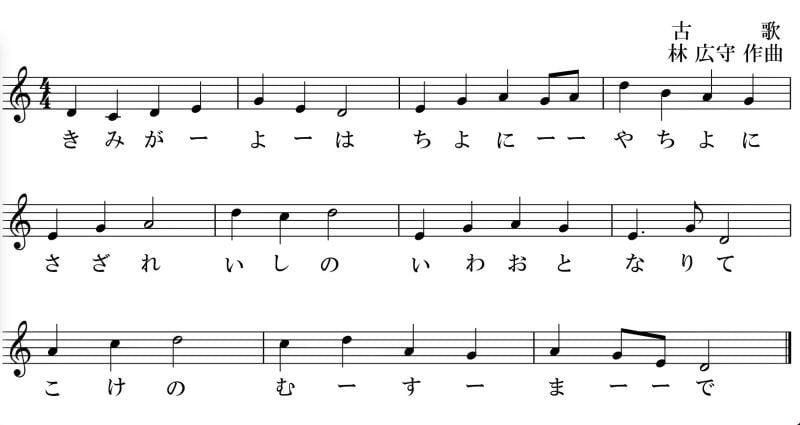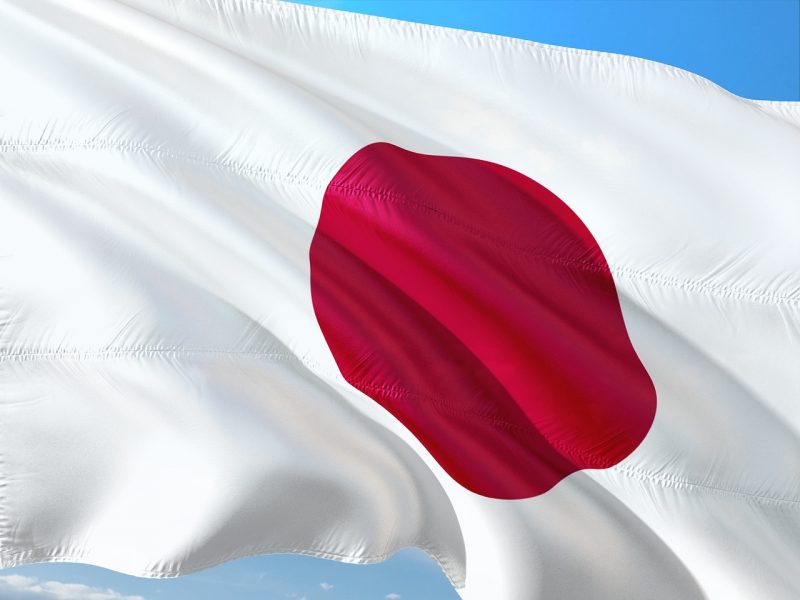Kimigayo [君が代] is the national anthem of Japan or Japan, it is also the oldest lyric anthem in the world, and also one of the shortest hymns in the world. It has only 5 sentences and 32 syllables, and was originally a poem.
For a long time, Kimigayo was known as the Anthem of Japan, but it only became an official anthem in 1999. In this article, we will examine a little of the history of this anthem and some curiosities.
Table of Content
Nihon no Kokka e Kokuminka - National Songs
The National Anthem in Japanese is Nihon no kokka [日本の国歌], something like song of the country or music of the country, Japan. It can be an instrumental song or music that symbolizes the nation. Before we talk about the Japanese Anthem, let's understand a little about the word kokka [国歌].
The kokka are regulated by the laws of each country, some are recognized by the common sense of the people, others are historically treated as national anthems. National anthems are not invariant, but can be revised and changed.
The other word we will see in this article is Kokuminka [国民歌], which refers to other national songs that are used to represent the nation. They are created for a specific public purpose, which is different from the national anthem, but intended to be sung by the people.
Production can be done not only by “governments”, but also by “people”, such as newspaper companies and private companies. In a broad sense, the theme song of a national event or defined as national because it is known by the people.
Kimigayo's History
The Japanese national anthem first appeared as an anonymous poem in the Kokin Wakashū (collection of poems) written around (794-1185). The poem was included in many anthologies and was used as a song celebrating long life by all kinds of people. This poem was sung at celebrations and anniversaries.
It all started in 1869, when John William Fenton, an Irish military leader, went to Japan and suggested to Ōyama Iwao that he choose an Anthem for Japan. Ōyama agreed, chose this poem, created the melody, and officially released the anthem in 1870.
During this time, the anthem underwent some changes in melody, and in 1888 the anthem was considered official, but when the Empire was dissolved after World War II, the anthem only became official again in 1999 along with the 日本の国旗.
See Kimigayo's lyrics below and their translation below:
Responsive Table: Scroll the table to the side with your finger >>
| Japanese | Romaji | Translation |
| 君が代は | Kimigayo wa | That the Emperor's monarchy |
| 千代に八千代に | Chiyo and Yachiyo | last for thousands and thousands of generations, |
| さざれ(細)石の | Sazare-ishi no | until the boulder |
| いわお(巌)となりて | Iwao to nose | become a rock |
| こけ(苔)の生すまで | Koke no musu made | And the mosses will cover it. |
The old versions of Kimigayo
Until reaching the current version, kimigayo had other previous versions with more stanzas, some had up to 3 parts, while the current Anthem is only a part with 5 phrases. Its use changed between the years 1880, 1888 and 1999.
The composers of the music of the Japanese anthem were Hiromori Hayashi, Yoshiisa Oku. Below, see how it is played in the score or cipher, along with the lyrics in hiragana.

Understanding the Japanese National Anthem
The word "kimi" refers to the Emperor and the words contain the prayer: "May the Emperor's reign last forever." The poem was composed at a time when the emperor ruled directly over the people.
During World War II, Japan was an absolute monarchy that took the emperor to the top. The Japanese imperial army invaded many Asian countries. The motivation was that they were fighting for the holy Emperor.
Subsequently, after World War II, the Emperor became the symbol of Japan according to the Constitution and lost all political power. Since then, several objections have been raised about singing "Kimigayo" as a national anthem.
However, at the moment, it continues to be sung at national festivals, international events, schools and national holidays.

Facts about the National Anthem of Japan
Schools were required to sing the anthem and salute the flag at events and graduations, teachers were required to encourage students to respect the flag. But there was great opposition from teachers who defended students' freedom of thought, belief and conscience.
The passing of the law caused the suicide of a school principal in Hiroshima who could not resolve the dispute between the school board and its teachers over the use of Hinomaru and “Kimigayo”.
Most Japanese considered “Kimigayo” the national anthem even before the National Flag and Anthem Law was passed in 1999.
Originally, the poem started with the phrase "Waga Kimi wa" ('you, my lord'), but the lyrics were changed during the Kamakura period to what we know as "Kimiga Yo wa" ('your reign').

Umiyukaba - Second National Anthem
In addition to the National Anthem Kimigayo, we have another very popular national song called Umiyukaba [海行かば] whose lyrics are based on a chōka poem by Ōtomo no Yakamochi from the Man'yōshū (poem 4094), an anthology of Japanese poetry from the 8th century, set to music by Kiyoshi Nobutoki.
"Umi Yukaba" later became popular among the military, especially the Imperial Japanese Navy. It became popular during and also after World War II. After Japan surrendered in 1945, "Umi Yukaba" and other gunka were banned.
However, the ban by the Occupying Nation (USA) was lifted and the song is now considered acceptable enough to be played publicly by the Japan Maritime Self-Defense Force, considered the second National Anthem which is also short.
Lyrics and Translation by Umi Yukaba
Responsive Table: Scroll the table to the side with your finger >>
| 海行かば水漬く屍 / | Umi yukaba / Mizuku kabane / | In the sea be my body drenched in water, |
| 山行かば草生す屍 / | Yama yukaba / Kusa musu kabane / | On land, with tall grass. |
| 大君の / 辺にこそ死なめ / | Okimi no / he ni koso shiname / | Let me die beside my Sovereign! |
| かえりみは / せじ | Kaerimi wa seji | I will never look back. |
List of national songs of Japan
There are many other secondary or historical hymns that were used by the Japanese to give glory to the nation. Below we will show a complete list of National Anthems or Songs for you to search and understand details:
- Umiyukaba [海行かば] - From Ichimo Otomo composed by Kiyoshi Nobutoki;
- It was 2600 [紀元二千六百年] - By Yoshio Masuda composed by Yoshihachiro Mori;
- The Dawn (Song of Youth) - Akeyukusora [明けゆく空 (青年の歌)];
- The sky is full of blue clouds - [空は青雲~全国青年団民謡];
- All the women march forward [全女性進出行進曲];
- Baseball Tournament Song [全国中等学校優勝野球大会の歌];
- Aerial singing [航空唱歌];
- Young Power - [若い力 (国民体育大会歌)];
- The crown shines on you [栄冠は君に輝く];
- Green Mountain River [緑の山河];
- We love [われら愛す];
- Young Japan [若い日本];
- Our Japan [われらの日本];
- Constitution [憲法音頭];
- Tokyo Olympics Ondo - NHK founded in 1964;
- To this day - songs from the Tokyo Olympics;
- World Expo Ondo;
- Hello from the world of country 1970;
- Pure White Earth (Singapore Winter Olympics anthem);
- Arco-íris e Balada de Neve (Música tema olímpica de Sapporo);
- Radio Gymnastics Song - Ichiro Fujiyama, NHK founded in 1951
- "PTA" song;
- Green Song (Green Feather Background Theme);
Kigenni Senropupakukun - Era 2600
A national song that was created in Japan in 1940 (Showa 15th year) in celebration of “Emperor Jinmu 2600”. It became popular on radio broadcasts and became famous. Created by Cabinet Celebration Party / Japan Broadcasting Corporation (now NHK).
Aikokukoushinkyoku - Patriotic march
The Patriotic March (Aikokukoushinkyoku) of 1937 is a favorite song of the Japanese, widely sung before the war. The lyrics are Yukio Morikawa and the composition is Tokichi Setoguchi. The song shows Japan's way of symbolizing eternal life and the ideal of Empire.
Japanese National Anthem videos
Finally, let's leave 2 videos, the first shows the Japanese National Anthem being sung in a stadium:
The following video by our friend Santana shows some curiosities about this National Anthem of Japan:
